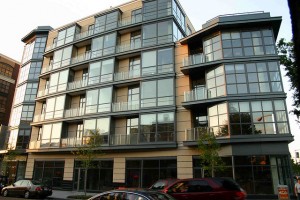Good morning, DCentric readers. It seems that cities are being ranked for everything these days, from where to raise kids to which city has the best tap water. How does D.C. rank? Find that and more below:
D.C. Named Best Place to Raise a Family Or so says Parenting Magazine, which reviewed 84 categories when creating its list of most family-friendly cities. D.C. topped the list with high marks for access to museums, kid-friendly restaurants and plenty of green space and parkland. According to the magazine, “You want the best for your family… and that includes great schools, affordable homes, low crime rates, plenty of jobs, and lots of parkland.” We’re not sure D.C. is really the best in all of those categories, but the city will take all of the positive press it can get at the moment. (NBC Washington)
A Refreshing Surprise: D.C. Tap Water Ranks Among Top 25 D.C.’s tap water isn’t typically included in conversations about the best-tasting water from around the country, but maybe it should be. A panel from the American Water Works Association got together, tasted water samples and ranked D.C. as 25th. Greenville, S.C. came in at number 1. (Washington City Paper)
Continue reading →
Last week’s Metro Connection featured a mobile market that will drive to D.C.’s food deserts and sell produce at reduced rates.
Arcadia Foods [is] a small organization that works to bring fresh produce from fields of local farms to the dinner plates of D.C. residents. The founder, Mike Babin, now has his sights set on the food deserts of D.C. by putting farmers’ markets like this one on wheels.
“We’ve got a bus and we’re calling it a mobile market that is going to be outfitted as a farmer’s market. It’s going to roll into these communities and set up shop for one day a week to just provide that food to those communities,” [Mike Babin says].

Flickr: Lisa Williams
Finding fresh and affordable produce can be a challenge in some D.C. neighborhoods.
The U.S. Department of Agriculture defines food deserts as areas with poor access to large grocery stories — and D.C. has plenty of neighborhoods that qualify. The food desert definition doesn’t take into account whether neighborhoods without chain grocers have corner stores selling produce or farmers markets.
Some LeDroit Park residents have pointed out on the neighborhood’s Listserv that although the area lacks a big grocery store, there are a couple of neighborhood options, including Common Good City Farm and farmers markets and corner stores. Some alternatives to chain grocers may not be as affordable, but that’s not always the case.
Babin’s plans may provide a temporary fix to food deserts, but as reporter Marc Adams points out, getting people to actually buy the produce takes more than just bringing the food into neighborhoods. LeDroit Park resident Jana Baldwin, who uses food stamps, tells Adams that “many communities may feel that [the mobile vendor's produce] is only for a specific population and so it would have to definitely be marketed in a way that was inclusive to all communities.”

Flickr: Scott Catron
Can difficult-to-pronounce Arabic names be as American as apple pie?
The Washington Post series about life for Muslim-Americans started off with the profile of a Palestinian-American who ditched his “Americanized” name for his legal one. His decision made me think about my own struggle in reclaiming my given name.
Fawaz Ismail grew up in Texas where he asked everyone to call him Tony, a name that “put people at ease.” He remained Tony after he moved to Northern Virginia, where he helped expand his family’s flag business. But Ismail dropped his nickname after the backlash against Muslims in the wake of the Sept. 11 attacks.
Now, a decade later, his name is a daily message to his fellow Americans: They must deal with him for who he is — a Muslim who loves his country and proudly sells its banner.
“A lot of people use a nickname to make it easier for Americans to pronounce,” he says, “but now, I don’t care. They’re going to have to pronounce my name. It’s not that hard — Fah-wahz.”
Many immigrants and second-generation Americans go by nicknames rather than their legal names for a number of reasons. I’m one such example. I grew up up in a small, rural and mostly-white Maryland town, and my parents decided I should go by the nickname Ele rather than my real, very Persian name: Elahe, the Arabic word for goddess (pronounced Eh-la-heh). They went by “Americanized” names themselves in an effort to make life easier, to assimilate as quickly as possible in a foreign land. And for 21 years, I was Ele (pronounced Elie). It wasn’t until after college that I decided to make the switch to my real name, both in my personal and professional worlds.
My decision was like Ismail’s; why must I accommodate or change my identity to convenience others or make them feel more comfortable?
Continue reading →
Early to rise, DCentric readers. Here are your morning links, hot and ready for your perusal. See something you think we missed? Email us at dcentric@wamu.org.
Do we really need to describe neighborhoods negatively? We’ve written before about using the word “ghetto” to describe a D.C. neighborhood. What about “hardscrabble?” Or calling it a “dive neighborhood?” This post asks not so much whether it’s necessary to use negative words to label Trinidad, but whether they are accurate. As a general rule, attempting to describe a complex, rapidly-changing neighborhood with any blanket term can be challenging. (The District Curmudgeon)
Scientists Measure the Accuracy of a Racism Claim Scientists are now saying a seminal study that debunked racist scientific claims was actually inaccurate itself. It’s all based on the infamous study by 19th-century anthropologist Samuel George Morton, who measured the skull size of people belonging to various races. Another scientist in the 1980s claimed that Morton was influenced by his biases. Now, scientists have remeasured the skulls and find that Morton’s measurements were mostly accurate. (The New York Times)
Continue reading →

Flickr: Rich Moffitt
Nutrition Inc., the food service company that delivers meals to D.C.’s home-bound seniors, shut down last week, leaving District officials scrambling to fill the void.
The company, which may have to file for bankruptcy, notified the D.C. Office on Aging of its impending closure a few days before the service stopped. The District is now relying on temporary vendors to fill in and has started looking for a new, permanent one. Initially, about 300 seniors who were the most vulnerable were given priority immediately after Nutrition, Inc.’s closure. The Washington Post reports that there was some disruption in services.
Now John Thompson, the Office of Aging’s acting executive director, tells DCentric that as of this week, everyone should be receiving their meals as normal. Service centers and new vendors have been running spot checks to ensure everyone who should be receiving a meal is getting one.
Continue reading →

Mandel Ngan/AFP/Getty Images
The Martin Luther King, Jr. Memorial will be ready for dedication in August.
Work on the Martin Luther King, Jr. memorial is almost complete, and the dedication is set for Aug. 28.
WUSA9 spoke with the chief sculptor, Lei Yi Xin of China, as he finished chiseling the 28-foot-sculpture by the Tidal Basin:
Speaking in Mandarin, Lei says this project is the most significant in his lifetime: “Dr. Martin Luther King, Jr. is a such a significant person in history. He is not only an American hero. He is also our world’s hero. It is also a huge significance that I am working on a project in the capital of the United States.”
Lei says he admires Dr. King for his fight for equality among people of all races.
The work is even more impressive considering that Lei did much of the sculpting from memory.
Some of you may remember the controversy surrounding the memorial, including the selection of Lei as the sculptor and criticism that King’s face was too harsh and confrontational. WUSA9 reports that “four separate faces were constructed and presented to Dr. King’s children. The family ultimately chose one of the faces, which was actually the original face of the sculpture.”
Good morning, DCentric readers. Below are the four stories we’re reading today. Have a link you’d like to share? Email us at dcentric@wamu.org.
Lawsuit Says Chief “Purged” MPD of Black Officers A police commander has accused D.C.’s Police Chief Cathy Lanier of “whitening” the police force. He claims in a lawsuit against Lanier that he was demoted without cause. Reporter Rend Smith also points out that the force remains majority black, although “the percentage has slowly been decreasing since the late 1990s.” (Washington City Paper)
Surging college costs price out middle class College is getting more expensive and the median income isn’t growing much. In fact, “if incomes had kept up with surging college costs, the typical American would be earning $77,000 a year.” In 2008, the median income was $33,000, so no, it’s not anywhere close enough to pay for college. Pile on the student loans! (CNN/Money)
Region resists fed sex offender rules The District is far from complying with a federal law requiring jurisdictions to create sex offender registries. Could D.C. end up a haven for violent offenders? Critics say yes, while D.C. Councilman Phil Mendelson says that “sounds like rhetoric to me.” Youth advocates point out that the rule keeps juvenile offenders on the list for 25 years, which could make families feel reluctant to report abuses. (Washington Examiner )
Under suspicion: American Muslims search for identity 10 years after Sept. 11 The Washington Post has begun its multi-part series examining the lives of American Muslims. In this first story, Marc Fisher speaks with families living in the D.C.-area, writing, “Osama bin Laden is dead, but his legacy colors the lives of the estimated 2.4 million American Muslims every day. Some have reacted to a decade of stares, cutting comments, airport humiliations and disturbing incidents of homegrown terrorism by drifting away from their religion, some by deepening their faith, and a few by turning to the very extremism that sparked the mistrust they encounter.” (The Washington Post)

Sandra Mu/Getty Images
Need strawberries? Try to buy organic if you can.
Buying organic may be better for your health, but it’s not always feasible for those on a budget. Months ago, we posted advice on how to prioritize buying organic. Now, a new list is out detailing which non-organic foods to avoid and which are OK to eat.
The list is based on the U.S. Department of Agriculture’s May report [PDF], rounding up all of the pesticides found in produce. Advocacy organization Environmental Working Group took the data, and created its “Dirty Dozen” and “Clean 15″ lists. The alliteration and rhyming should make the foods easier to remember, right? If not, you can print the EWG’s brochure, posted below.
NPR reports:
The EWG suggests that people buy organically grown fruits and vegetables for the varieties on its list of the most likely to carry pesticide residues. But the group also says the health benefits from produce mean that “eating conventionally-grown produce is far better than not eating fruits and vegetables at all.”
Continue reading →
Good morning, DCentric readers! Here are the five links you should click today:
Meal Service Company In D.C. Shuts Down The company that serves meals to those in need in D.C. since 1976 has stopped providing meals due to financial difficulties. The city’s Office on Aging is trying to find another provider to fill the gap. (WAMU)
Increased Police Presence, Classical Music Being Used To Combat Rowdy Teenagers in Chinatown The National Portrait Gallery doesn’t like teenagers hanging out on their front steps at night, so they’ve installed speakers to play classical music — because apparently teenagers hate classical music so much that they flee from the very sound of it? Also implicit in the tactic is the assumption that young people hanging out on the steps equals trouble. “Because of complaints and random crime, D.C. Police have beefed up patrols. Some young men told FOX 5 on Friday… there are some bad apples, but authorities seem to crack down on everyone.” (myfoxdc.com)
Continue reading →

Flickr: Elvert Barnes
Home prices are on the rise in D.C., and many folks are looking to buy. Housing Complex digs into the high demand for condos, while pointing out there are still very affordable options in parts of Wards 7 and 8, the District’s poorest neighborhoods:
So why aren’t all those people angling for condos willing to take advantage of lower housing prices east of the river, like they did in previously marginal Northwest neighborhoods?
There are a few clear differences between the neighborhoods that capture the people who move here for jobs in the booming Washington economy, and the ones that don’t. Areas with historic housing stock, like LeDroit Park and Shaw, are the first ones to go. They also must have access to transit, and preferably be within walking distance to a commercial strip like H Street NE. White yuppies, of course, aren’t the only ones turning down neighborhoods east of the river: Native Washingtonians who sell their now-valuable properties in gentrifying areas usually trade their D.C. addresses in for more land in Prince George’s County, unwilling to pay hundreds of thousands of dollars for a house they remember costing what you might now pay for a car.








